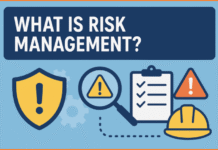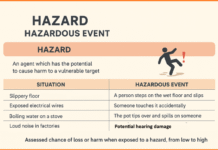In the field of occupational health and safety, the Hierarchy of Controls serves as a systematic approach to minimize or eliminate workplace hazards. Developed by the National Institute for Occupational Safety and Health (NIOSH), this framework prioritizes control measures based on their effectiveness in reducing risks. The five levels of the Hierarchy of Controls are: Elimination, Substitution, Engineering Controls, Administrative Controls, and Personal Protective Equipment (PPE).
Contents
Elimination
At the top of the hierarchy is elimination, which involves completely removing the hazard from the workplace. This is the most effective control measure as it eradicates the risk at its source. For example, if a company identifies hazardous chemicals in its processes, switching to alternative non-hazardous materials or redesigning the process to eliminate the use of such substances would be an elimination strategy.
Substitution
If complete elimination is not feasible, substitution comes into play. This control involves replacing a hazardous substance or process with a less hazardous one. For instance, replacing a toxic cleaning agent with an environmentally friendly and less harmful alternative is a substitution measure. While not as potent as elimination, substitution can significantly reduce the risk associated with a particular task or process.
Engineering Controls
Engineering controls involve designing and implementing physical changes to the workplace to reduce or eliminate hazards. This level of control aims to isolate individuals from the hazard or create a barrier between the worker and the danger. Examples include installing ventilation systems to control exposure to airborne contaminants, enclosing noisy machinery to reduce noise levels, or using machine guards to prevent contact with moving parts. Engineering controls are effective because they don’t rely on human behavior for success.
Administrative Controls
When elimination, substitution, or engineering controls are not sufficient, administrative controls become crucial. These measures focus on changing the way people work and include policies, procedures, training, and work schedules. For example, rotating workers to minimize their exposure to a specific hazard, implementing strict protocols for handling hazardous materials, or providing training on safe work practices are all administrative controls. While effective, they are considered less reliable than the controls higher in the hierarchy, as they depend on consistent adherence by individuals.
Personal Protective Equipment (PPE)
At the bottom of the hierarchy is the use of personal protective equipment (PPE). When other control measures are not possible or are insufficient, workers are provided with PPE to protect themselves from identified hazards. This can include items such as gloves, safety glasses, helmets, respirators, and more. While PPE is an essential component of workplace safety, it is the least effective because it relies heavily on proper selection, use, and maintenance by individuals.
Let’s consider an example of the Hierarchy of Controls in the context of a manufacturing facility where workers are exposed to hazardous fumes during a particular operation.
- Elimination:
- The company decides to eliminate the use of the hazardous substance causing the fumes by replacing it with a non-toxic alternative in the manufacturing process.
- Example: If a toxic cleaning solvent is being used, it is replaced with a non-toxic, environmentally friendly solvent.
- Substitution:
- If complete elimination is not feasible, the company explores substitution options to reduce the toxicity of the substance.
- Example: Instead of using a highly toxic chemical, the company switches to a less hazardous but equally effective chemical for the same process.
- Engineering Controls:
- The company introduces engineering controls to isolate workers from the hazardous fumes.
- Example: Installing a local exhaust ventilation system near the source of the fumes to capture and remove them before they can reach the breathing zone of the workers.
- Administrative Controls:
- The company implements administrative controls to further minimize exposure and ensure safe work practices.
- Example: Establishing strict protocols for the handling and use of the substance, including guidelines for the duration of exposure and mandatory breaks to reduce overall exposure time.
- Personal Protective Equipment (PPE):
- As a last resort, the company provides workers with appropriate PPE to protect them from any residual exposure.
- Example: Workers are required to wear respiratory protection, such as respirators with specific filters, to further reduce inhalation risks.
In this example, the Hierarchy of Controls is applied systematically. The company starts by attempting to eliminate or substitute the hazardous substance, moves on to engineering controls to control exposure at the source, implements administrative controls to regulate work practices, and finally, provides PPE as a supplementary measure. This layered approach ensures that multiple barriers are in place to protect workers, with priority given to the most effective control measures at the top of the hierarchy.
Example of Hierarchy of control for working at height
Let’s consider the Hierarchy of Controls in the context of work at height, a common scenario in construction and maintenance activities.
- Elimination:
- The company determines if it’s possible to eliminate the need for work at height altogether.
- Example: Designing structures or equipment that do not require subsequent maintenance or inspection at height, thus eliminating the need for workers to be exposed to the risk of falling.
- Substitution:
- If elimination is not feasible, the company explores substitution options to minimize the risk associated with working at height.
- Example: Using a drone equipped with cameras for visual inspections instead of sending a worker to heights for routine checks.
- Engineering Controls:
- Implementing engineering controls to create physical barriers or safe platforms that reduce the risk of falling.
- Example: Installing guardrails, safety nets, or scaffolding to provide a secure working platform and prevent falls.
- Administrative Controls:
- Establishing policies and procedures to regulate work at height and ensure safe practices.
- Example: Implementing a permit-to-work system that outlines specific safety measures, such as ensuring workers are properly trained, and scheduling work at height during optimal weather conditions.
- Personal Protective Equipment (PPE):
- Providing workers with appropriate personal protective equipment as a last line of defense.
- Example: Requiring workers to wear personal fall arrest systems, including harnesses and lanyards, when working at heights where other controls are not sufficient.
In the hierarchy for work at height, the goal is to first eliminate or minimize the need for work at height, then provide physical safeguards through engineering controls, establish administrative controls to ensure safe practices, and finally, equip workers with PPE as a precautionary measure. This layered approach ensures a comprehensive strategy for preventing falls and minimizing the risks associated with working at heights.
FAQs: Hierarchy of Control in Workplace Safety
- What is the Hierarchy of Control? The Hierarchy of Control is a systematic approach to managing workplace hazards, prioritizing measures based on their effectiveness in reducing or eliminating risks. The five levels in the hierarchy are Elimination, Substitution, Engineering Controls, Administrative Controls, and Personal Protective Equipment (PPE).
- Why is the Hierarchy of Control important? The hierarchy provides a structured framework for organizations to implement effective safety measures. It helps in selecting the most robust controls to minimize or eliminate workplace hazards, thereby creating safer work environments.
- What is the first level of the Hierarchy of Control? The first level is Elimination, which involves removing the hazard entirely. This is considered the most effective control measure.
- Can you provide an example of Elimination in the workplace? Certainly. If a company identifies hazardous chemicals in its processes, the elimination strategy would involve replacing those chemicals with non-hazardous alternatives or redesigning the process to eliminate the use of such substances.
- What comes after Elimination in the Hierarchy of Control? The second level is Substitution, where the goal is to replace a hazardous substance or process with a less hazardous one. This may involve using safer materials or processes.
- How do Engineering Controls differ from other levels? Engineering Controls involve physical changes to the workplace to reduce or eliminate hazards. Examples include ventilation systems, machine guards, or modifications to the work environment.
- What is the role of Administrative Controls in the Hierarchy? Administrative Controls focus on changing the way people work through policies, procedures, training, and scheduling. They help manage risks by establishing guidelines and protocols for safe work practices.





